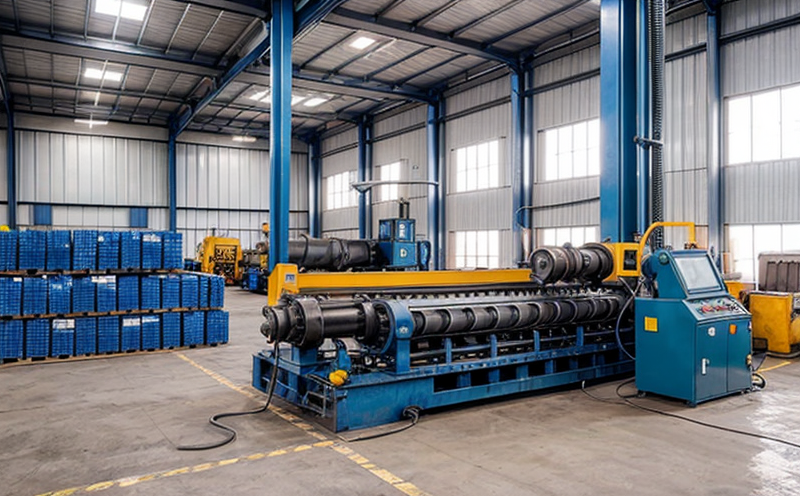ISO 13482 Service Robot Safety Compliance Testing in Trade
The ISO 13482 standard is a critical framework for ensuring that service robots are safe and reliable, particularly when they enter new markets. This standard mandates rigorous testing to ensure compliance with safety requirements set by the International Organization for Standardization (ISO). In the realm of Government & Trade Facilitation Testing, specifically within Industrial Goods & Machinery Trade Compliance Testing, ISO 13482 plays a pivotal role in facilitating trade between countries by ensuring that service robots meet international safety standards.
Service robots are designed to perform tasks autonomously or semi-autonomously without human intervention. They operate in various environments and interact with different types of people, making their safety paramount for both end-users and the global trade community. Compliance testing under ISO 13482 ensures that these robots can be safely traded across borders, reducing the risk of non-compliance penalties and enhancing market access.
The standard covers a wide range of aspects including mechanical stability, electrical integrity, software safety, human-robot interaction, and environmental conditions. It specifies detailed test procedures to evaluate these factors comprehensively. By adhering to this standard, manufacturers can demonstrate that their products meet the stringent requirements set by international authorities, thereby paving the way for successful trade.
Our laboratory specializes in providing ISO 13482 compliance testing services tailored specifically for service robots. We employ state-of-the-art equipment and methodologies to ensure accurate and reliable results. Our team of experts is well-versed in interpreting these standards and can guide you through every step of the process, from initial consultation to final certification.
To summarize, ISO 13482 compliance testing is essential for service robots seeking entry into international markets. It ensures that these advanced machines are safe not only within their intended environments but also when interacting with diverse populations across different regions. By partnering with us, you can ensure smooth and trouble-free trade facilitation.
Applied Standards
The ISO 13482 standard is widely recognized as the gold standard for ensuring safety in service robots. It addresses several key areas critical to the development and deployment of these machines:
- Mechanical Stability: Ensuring that the robot maintains its structural integrity under various operational conditions.
- Electrical Integrity: Guaranteeing safe operation by preventing electrical hazards such as short circuits or overheating.
- Software Safety: Protecting against software failures that could compromise safety.
- Human-Robot Interaction: Designing the robot to interact safely with humans in shared spaces.
- Environmental Conditions: Ensuring robust performance across diverse environmental conditions encountered during trade and usage.
These standards are not only essential for compliance but also contribute significantly to enhancing public confidence in robotic technology. By adhering to these guidelines, manufacturers can ensure that their products meet the highest safety benchmarks.
Scope and Methodology
| Testing Parameter | Test Procedure | Acceptance Criteria |
|---|---|---|
| Mechanical Stability | Conduct static load tests to determine the maximum weight that can be supported by the robot without failure. | The robot must not show any signs of deformation or structural damage under specified loads. |
| Electrical Integrity | Perform insulation resistance testing and ground fault circuit interrupter (GFCI) checks to ensure electrical safety. | The insulation resistance should be above a specified threshold, and the GFCI must operate correctly within acceptable time limits. |
| Software Safety | Review software code for potential vulnerabilities or errors that could lead to hazardous situations. | No critical bugs or flaws identified during code reviews and automated testing. |
| Human-Robot Interaction | Conduct simulated interaction scenarios where the robot must respond safely in various emergency situations. | The robot should follow predefined safety protocols without causing harm to humans. |
| Environmental Conditions | Subject the robot to environmental stress tests including temperature, humidity, and vibration. | The robot must function properly within specified limits for each environmental parameter. |
The methodology employed during testing involves a comprehensive approach that includes both laboratory-based evaluations and field trials where applicable. Our team uses advanced instrumentation and software tools to ensure accurate data collection and analysis throughout the process. This ensures that all aspects of ISO 13482 are thoroughly addressed, resulting in robust compliance reports.
Benefits
Compliance with ISO 13482 brings numerous benefits to manufacturers and importers:
- Enhanced Safety: Ensures that service robots operate safely in diverse environments, reducing risks to users.
- Improved Market Access: Facilitates easier entry into international markets by meeting stringent safety standards.
- Increased Reputational Value: Establishes a strong brand reputation for quality and reliability among consumers and regulatory bodies.
- Avoidance of Non-Compliance Penalties: Prevents potential fines or sanctions from non-compliance with international regulations.
- Informed Decision-Making: Provides detailed insights into product performance, aiding in continuous improvement.
- Customer Confidence: Builds trust with customers who value safety and reliability in robotic technology.
- Simplified Compliance Process: Offers a streamlined approach to meeting international standards through our specialized testing services.
In conclusion, ISO 13482 compliance is not just a regulatory requirement but also an opportunity for businesses to enhance their products and expand into new markets. By partnering with us, you can ensure that your service robots are ready for successful trade facilitation.





